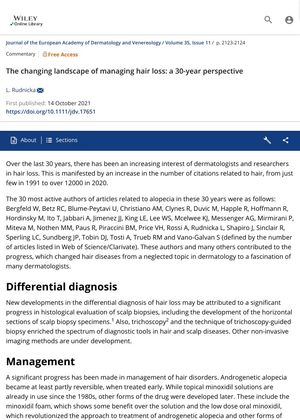The Changing Landscape of Managing Hair Loss: A 30-Year Perspective
October 2021
in “
Journal of the European Academy of Dermatology and Venereology
”
histological evaluation scalp biopsies trichoscopy trichoscopy-guided biopsy androgenetic alopecia minoxidil 5-alpha reductase inhibitors hair transplantation follicular unit extraction FUE alopecia areata Janus kinase inhibitors JAK inhibitors systemic diseases classification systems scoring systems COVID-19 severe COVID-19 Rogaine Propecia hair transplant

TLDR There have been major advances in diagnosing and treating hair loss over the last 30 years, with new drugs and improved hair transplant techniques.
Over the past 30 years, there has been significant progress in the diagnosis and management of hair loss. Developments in histological evaluation of scalp biopsies, trichoscopy, and trichoscopy-guided biopsy have improved the differential diagnosis of hair loss. In terms of management, androgenetic alopecia has become partly reversible when treated early, with drugs like minoxidil and 5-alpha reductase inhibitors showing effectiveness. Hair transplantation techniques have also improved, with follicular unit extraction (FUE) becoming the standard. For alopecia areata, Janus kinase inhibitors (JAK) are showing promise as the first group of drugs developed and approved for this condition. The past 30 years have also seen the identification of new hair loss diseases and the development of methods for early identification of systemic diseases causing hair loss. It's now understood that hair loss can significantly impact quality of life and can be a symptom of systemic factors and comorbidities. Several classification and scoring systems have been developed to categorize and assess the severity of hair loss. The COVID-19 pandemic has also stimulated studies on hair loss, indicating that men with androgenetic alopecia are at increased risk of developing severe COVID-19.










